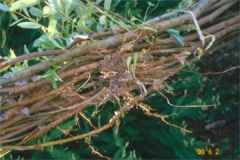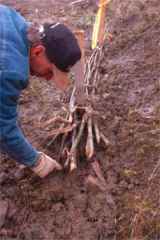
Salix | Esenss.com | Biodraw | Erosiondraw | info@salixaec.com


|
Stafford Slide Biotechnical Erosion Control Project
PHOTO DOCUMENTATION:
Stafford Slide part 1
Stafford Slide part 2
Stafford Slide part 3
Stafford Slide part 4
NORTH SLIDE
Salix Applied Earthcare first trained PALCO workers on willow harvesting methods, bundling of willow wattles and live fascines, and construction and placement of the wattles, fascines, modified brush layers, live pole drains, and live stakes. The North Slide received biotechnical erosion control treatment first.
On the North Slide, workers constructed 35 willow wattles, for a total coverage of 385 linear feet of wattles. The wattles were also used in combination with the brushlayering biotechnical technique, and these are called “modified brush layers” or “MBLs”. A total of 31 modified brush layers were constructed on the North Slide, for a total coverage of 420 linear feet.
Additionally, 20 live pole drains were constructed on the slopes, for a total of 782 linear feet of pole drains. A live pole drain (LPD) is a biotechnical and reclamation technique that is intended to drain excess moisture away from an unstable site. The drains are constructed of one or more live fascine bundles, which are similar willow wattles with the exception that the basal ends of the branches are oriented in the same direction. Unstable slopes, landslides, and small slumping gullies can often be successfully treated with live pole drains. This is a good technique to initiate the process of natural healing.
Live staking, a biotechnical method which involves driving a single willow stake into the ground, was also applied on various areas of the North Slide which did not receive the other aforementioned treatments. Approximately 600 linear feet of live stakes were planted, ranging from 1-3 feet apart.

|
Stafford Slide
Biotechnical Erosion Control was used to help stabilize the Stafford Slide, reduce surficial erosion, and revegetate bare, exposed slopes. PALCO workers harvested cuttings of locally-adapted willow species. The miracle of willow is that it can form adventitious roots from the portion of the stem that is in contact with soil and water, while branches sprout above. The roots eventually spread out and stabilize the soil. Biotechnical systems are strong initially and grow stronger with time as the vegetation becomes established. The photo above shows a willow wattle which is beginning to form adventitious roots. (Stafford Slide, June 2, 2000)


This live pole drain was installed on the North Slide in order to help drain excess moisture from the slope.
|
|
|
|
|

Copyright 2003-2011 - Salix Applied Earth Care - 2455 Athens Ave Ste. A - Redding, CA 96001 - (530)247-1600 - web development by Uberwirks.com |